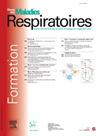Jacketed respiratory inductive plethysmography in rats: A translational non-invasive method for cardiorespiratory exercise monitoring
IF 0.5
4区 医学
Q4 RESPIRATORY SYSTEM
引用次数: 0
Abstract
Introduction
Respiratory inductive plethysmography (RIP) is one of the least restrictive methods for evaluating pulmonary ventilation. It has been used in humans since the 1980s as one of the clinical tests for functional exploration of the respiratory system under different conditions (sleep, rest or exercise) in healthy and in respiratory pathology patients. This method has been adapted and integrated into jacketed telemetry systems used in preclinical large animal research (safety pharmacology, fundamental or applied research, etc.). Thanks to the recent miniaturisation of jacketed telemetric systems, a new solution is available for assessing respiratory function combined with ECG in small mammals [1] (i.e. rats). As exercise was initially used to validate the measurement accuracy of dual-band respiratory inductance plethysmography in humans, it was of interest to qualify this solution in a similar way in rats. The aim is to assess the feasibility of a translational model using this technology to monitor physiological changes associated with exercise on a treadmill.
Methods
For this purpose, male Wistar rats (n = 10.8-9 weeks old) were exposed to an incremental treadmill exercise protocol with speed levels from 5 to 45 cm. s-1. Respiratory parameters (respiratory rate (RespR), minute ventilation (VM), Tidal volume (VT)) and peak inspiratory and expiratory flow (PIF, PEF, PENH) as well as cardiac (heart rate (HR)) and activity level (AL) were continuously monitored and analyzed over the last 30 seconds of each level.
Results
All animals were successfully fitted with the device and returned to their home cages. The control values measured after stabilization were for RespR 165 ± 8 brpm, HR 407 ± 9 bpm and AL 24 ± 4 mg. At least all animals ran successfully on the treadmill with the vest up to 35 cm/sec (n = 10), some reaching 45 cm/sec (n = 6). For the maximum plateau, exercise induced a significant physiological increase (Fig. 1) in respiratory parameters (RespR +74%, 116 ± 26 brpm, P < 0.01**//MV +334%, 1099 ± 197 mL. min-1, P < 0.01**//VT +197%, 4 ± 1 mL, P < 0.01**), as well as HR (+36%, 140 ± 13 bpm, P < 0.05*) and AL (+2358%, 504 ± 57 bpm, P < 0.05*). PIF and PEF showed a significant increase of 86 ± 9 ml. s-1 and 52 ± 11 mL. s- respectively. enhanced Pause (PENH) remained stable during exercise indicating no significant variation of airflow limitation.
Conclusion
In conclusion, this new telemetry jacket can be used to monitor the adaptation of respiratory parameters during a standard forced exercise protocol and in a non-invasive way in rats. It is convenient to use and well tolerated by the animal. This alternative method could be used to refine respiratory monitoring in exercise protocols and offers new perspectives for studying pathological and/or pharmacological phenotype alterations in various models.
大鼠夹套呼吸感应式胸压测量法:心肺运动监测的非侵入性转化方法
呼吸诱导容积描记(RIP)是评价肺通气的一种限制性最小的方法。自20世纪80年代以来,它一直用于人体,作为健康和呼吸系统病理患者在不同条件下(睡眠,休息或运动)呼吸系统功能探索的临床试验之一。该方法已被改编并集成到临床前大型动物研究(安全药理学、基础或应用研究等)中使用的夹套遥测系统中。由于最近夹套遥测系统的小型化,一种新的解决方案可用于评估小型哺乳动物[1](即大鼠)结合ECG的呼吸功能。由于运动最初被用于验证人类双波段呼吸感应容积描记仪的测量准确性,因此在大鼠中以类似的方式验证该溶液是有意义的。目的是评估利用该技术监测与跑步机运动相关的生理变化的转化模型的可行性。为此,将雄性Wistar大鼠(n = 10.8-9周龄)暴露于速度水平为5至45 cm的增量跑步机运动方案中。s - 1。连续监测呼吸参数(呼吸频率(RespR)、分气量(VM)、潮气量(VT)、吸气和呼气峰值流量(PIF、PEF、PENH)以及心率(HR)和活动水平(AL),并分析每个水平的最后30秒。结果所有动物均成功安装该装置,并返回家笼。稳定后测量的控制值为RespR 165±8 bpm, HR 407±9 bpm和AL 24±4 mg。至少所有的动物在跑步机上都能成功地跑到35厘米/秒(n = 10),有些动物达到45厘米/秒(n = 6)。在最大的平台上,运动引起了呼吸参数的显著生理增加(图1)(RespR +74%, 116±26 brpm, P和lt;0.01**//MV +334%, 1099±197 mL. min-1, P <;0.01**//VT +197%, 4±1ml, P <;0.01 * *),以及人力资源(+ 36%,140±13 bpm, P & lt;0.05*)和AL(+2358%, 504±57 bpm, P <;0.05 *)。PIF和PEF分别显著增加86±9 ml. s-1和52±11 ml. s-1。增强暂停(PENH)在运动期间保持稳定,表明气流限制没有显著变化。结论该套可用于大鼠标准强迫运动过程中呼吸参数适应的无创监测。使用方便,动物耐受性好。这种替代方法可用于改进运动方案中的呼吸监测,并为研究各种模型的病理和/或药理表型改变提供了新的视角。
本文章由计算机程序翻译,如有差异,请以英文原文为准。
求助全文
约1分钟内获得全文
求助全文
来源期刊

Revue des maladies respiratoires
医学-呼吸系统
CiteScore
1.10
自引率
16.70%
发文量
168
审稿时长
4-8 weeks
期刊介绍:
La Revue des Maladies Respiratoires est l''organe officiel d''expression scientifique de la Société de Pneumologie de Langue Française (SPLF). Il s''agit d''un média professionnel francophone, à vocation internationale et accessible ici.
La Revue des Maladies Respiratoires est un outil de formation professionnelle post-universitaire pour l''ensemble de la communauté pneumologique francophone. Elle publie sur son site différentes variétés d''articles scientifiques concernant la Pneumologie :
- Editoriaux,
- Articles originaux,
- Revues générales,
- Articles de synthèses,
- Recommandations d''experts et textes de consensus,
- Séries thématiques,
- Cas cliniques,
- Articles « images et diagnostics »,
- Fiches techniques,
- Lettres à la rédaction.
 求助内容:
求助内容: 应助结果提醒方式:
应助结果提醒方式:


